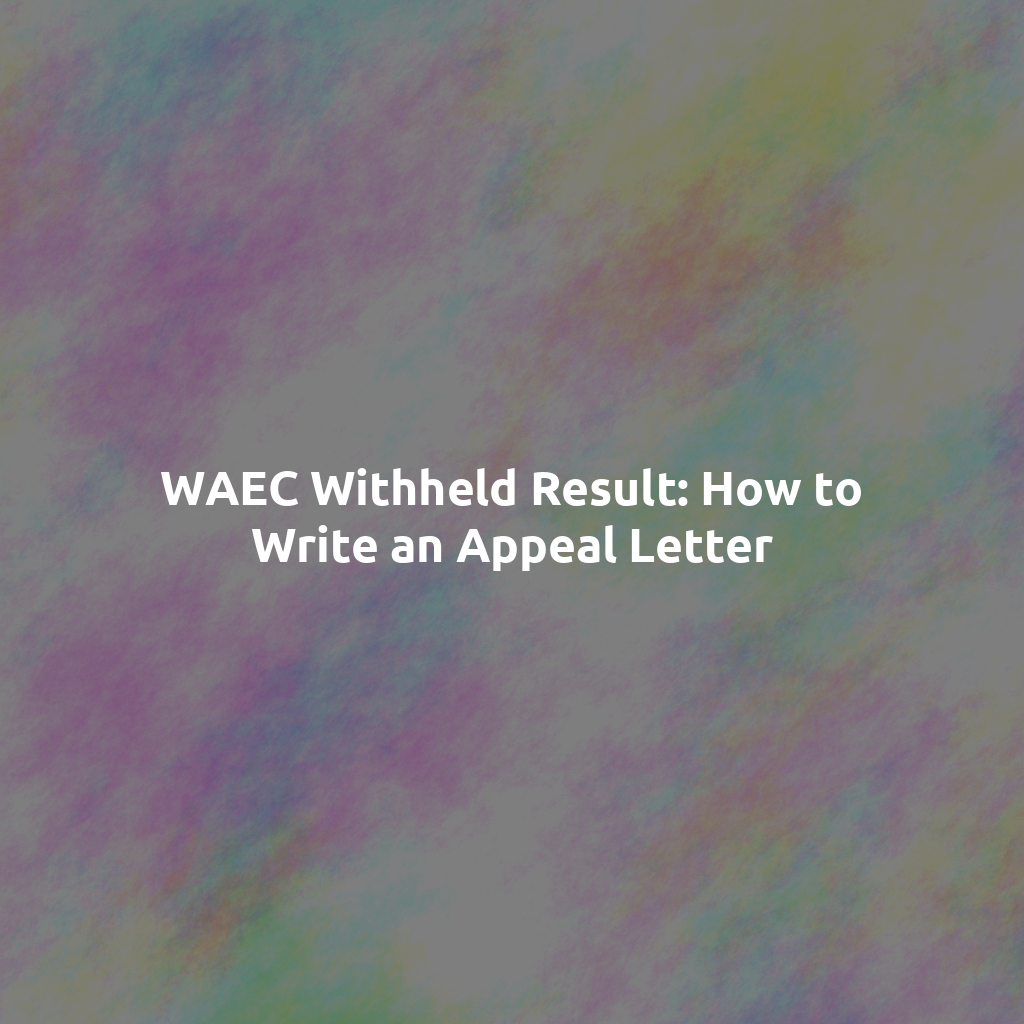Introduction to WAEC Withheld Results
WAEC withheld results can be a source of anxiety for students and their families.
These results are not released due to various issues, often involving examination conduct.
Understanding the reasons for withholding can help in addressing the situation effectively.
In many cases, students may wish to appeal the decision regarding their withheld results.
This necessitates writing a formal appeal letter to the appropriate authority.
Advertisements
An appeal letter serves as a request for reconsideration of the withheld status.
Writing this letter correctly is crucial for gaining a favorable outcome.
In the following sections, we will discuss how to write an effective appeal letter.
Reasons for Withheld Results
Several factors can lead to a student’s result being withheld by WAEC.
Common reasons include examination malpractice allegations.
Administrative errors during the results processing phase can also play a role.
Additionally, discrepancies in submitted materials may cause results to be put on hold.
Each case has unique circumstances that require careful examination.
The Importance of an Appeal Letter
A well-written appeal letter can significantly impact the outcome of your situation.
This letter provides an opportunity to present your case directly to WAEC.
It demonstrates your commitment to resolving any issues regarding your results.
Advertisements
Furthermore, it can highlight your academic dedication and integrity.
Ultimately, an effective appeal letter can lead to the release of your results.
Understanding the Reasons Behind Withheld Results
Common Reasons for Withholding Results
Withheld results can arise from several factors.
Initially, discrepancies in scoring may trigger this action.
Additionally, issues with student identity verification often contribute.
Furthermore, administrative errors may lead to unexpected results.
Moreover, cases of examination malpractice frequently cause a hold on results.
Impact of Withheld Results on Students
Holding results can significantly affect students’ futures.
For instance, it may delay college admissions and scholarship applications.
Moreover, it can cause stress and anxiety among students and their families.
Consequently, understanding the reasons is crucial for effective resolution.
Steps to Resolve Withheld Results
Several steps can help address withheld results effectively.
Firstly, students should contact their examination board promptly.
Secondly, gathering necessary documentation is essential for clarity.
Additionally, seeking guidance and support from school officials can be beneficial.
Moreover, staying informed about the appeal process is crucial.
Importance of Appealing a Withheld Result
Understanding the Appeal Process
Appealing a withheld result can be a crucial step for students.
This action allows you to rectify any discrepancies in your examination results.
Furthermore, it opens the door to potential opportunities for your academic progress.
Benefits of Filing an Appeal
An appeal can lead to the release of your examination results.
Consequently, accessing your results can help you make informed decisions about your future.
Moreover, it enhances your chances of pursuing higher education or job opportunities.
Potential Outcomes of an Appeal
There are various outcomes when you appeal a withheld result.
First, your appeal may result in the release of your results.
Alternatively, the examination body may uphold the decision to withhold your results.
In some cases, additional requirements may be imposed to resolve your issue.
Acknowledging the Impact of Delayed Results
Delays in receiving results can have significant impact on your education.
Some students may miss application deadlines due to withheld results.
Additionally, it can affect scholarship opportunities or job placements.
Taking the Initiative
Proactively appealing your result demonstrates your commitment to your education.
This initiative can also portray your determination to address academic challenges.
Ultimately, appealing is a strategic move toward securing your academic future.
Components of a Well-Structured Appeal Letter
Clear Identification
Your appeal letter must clearly identify you and your situation.
Start with your name, address, and phone number.
Next, include your examination details for reference.
Lastly, state the purpose of the letter upfront.
Polite Salutation
Begin with a respectful greeting.
A simple “Dear [Examining Body]” works well.
Establish a friendly tone right from the start.
Introduction
Introduce yourself and the reason for your appeal.
Clearly state the specific result being withheld.
Provide context regarding your examination performance.
Body of the Letter
This section should explain your case in detail.
Firstly, outline any relevant circumstances surrounding your result.
Include any evidence that supports your claim.
Moreover, be concise and stick to facts.
Use bullet points for clarity where needed.
Expression of Concern
Share how the withheld result affects you personally.
Explain the implications for your education or future plans.
Furthermore, express your feelings of concern or disappointment.
Request for Action
Clearly state what you want from the examining body.
Ask for a prompt review of your case.
Encourage them to rectify any potential errors.
Polite Closing
Thank the recipient for their time and consideration.
Use a courteous phrase to sign off your letter.
“Yours sincerely” or “Best regards” are suitable choices.
Your appeal letter should start with your contact information.
Include your full name, address, and phone number at the top.
Next, add the date of writing the letter.
Clearly mention the recipient’s contact information.
This includes the name and title of the WAEC official.
After this, include a formal greeting.
Address the recipient appropriately, using “Dear” followed by their title and name.
Opening Paragraph
Your opening paragraph should state the purpose of your letter.
Mention your name and examination number clearly.
Explain briefly why your result is withheld.
Body of the Letter
In the body, provide specific details of the issue.
Mention any relevant examination policies or guidelines.
Include dates, subjects, and any pertinent identifiers related to your case.
Emphasize your qualifications and achievements before this incident.
Keep the tone respectful and professional throughout.
Closing Paragraph
Your closing paragraph should reiterate your request for action.
Express your hope for a prompt review of your case.
Thank the recipient for considering your appeal.
Include a polite closing line such as “Sincerely” or “Yours faithfully”.
Signature
After the closing line, leave space for your handwritten signature.
Then, type your full name below the signature space.
Additional Tips
Ensure your letter is typed neatly and free of errors.
Use clear and concise language throughout.
Consider including copies of relevant documents to support your appeal.
Tips for Writing an Effective Appeal Letter
Understand the Reason for Withholding
Begin by clarifying why your WAEC result is withheld.
This understanding forms the basis of your appeal.
Ensure you gather all relevant information regarding the issue.
Use a Professional Tone
Maintain a respectful and formal tone throughout your letter.
Express your concerns clearly without being confrontational.
A professional approach increases your chances of a favorable outcome.
Be Clear and Concise
State your points succinctly to avoid confusion.
Avoid unnecessary details that do not support your appeal.
Use straightforward language to convey your message.
Include Relevant Details
Provide your full name, registration number, and contact information.
Attach any necessary documentation to support your case.
These details help the authorities identify your record easily.
Request a Review
Clearly state your request for a review of your result.
Explain why you believe the decision to withhold your result should be reconsidered.
Make your case compelling with valid arguments.
Proofread Your Letter
Before sending, check your letter for any errors.
Ensure that grammar and spelling are correct throughout.
A well-presented letter leaves a positive impression.
Follow Up
After submission, follow up on your appeal after a reasonable period.
Be polite and inquire about the status of your appeal.
This shows your commitment and seriousness regarding the matter.
Common Mistakes to Avoid When Writing an Appeal Letter
Insufficient Detail
One common mistake is lacking detail in your appeal letter.
Be specific about the reasons for your appeal.
Provide relevant documentation to support your claims.
Emotional Language
Avoid using overly emotional language in your letter.
Stick to factual statements rather than emotional expressions.
This keeps your appeal professional and respectful.
Lack of Structure
A poorly structured letter can confuse the reader.
Use clear paragraphs to organize your thoughts logically.
Start with an introduction, followed by body paragraphs, and finish with a conclusion.
Missing Contact Information
Always include your contact information in the letter.
This makes it easy for the organization to respond.
Include your full name, address, phone number, and email address.
Ignoring Guidelines
Each organization often has specific guidelines for appeals.
Make sure to read and follow all provided instructions.
Failure to do so may result in automatic denial of your appeal.
Neglecting Proofreading
Spelling and grammar errors can undermine your appeal.
Always proofread your letter before sending it.
Consider asking a friend or family member for feedback.
Steps to Submit the Appeal Letter to WAEC and Follow-Up Process
Preparing Your Appeal Letter
Begin by clearly stating your purpose in the letter.
Include your full name, examination number, and contact details.
State the reason why your result was withheld.
Provide any supporting documents that can help your case.
Express your request for a review of your results.
Formatting Your Appeal Letter
Use a formal tone throughout your letter.
Ensure your letter is properly formatted and free from errors.
Keep your letter concise and direct.
Sign the letter and include the date at the bottom.
Submitting Your Appeal
Send your appeal letter via a reliable method.
Consider using a registered postal service for tracking.
Alternatively, submit your letter directly to WAEC offices.
Ensure you keep a copy of your submission for reference.
Following Up on Your Appeal
After submitting, wait for at least four weeks for a response.
If you do not receive a reply, contact WAEC directly.
Use the official email or phone number for inquiries.
Maintain a record of all your communications for future reference.
Stay polite and patient throughout the follow-up process.





